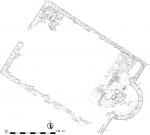Summary (English)
This was the 16th excavation campaign undertaken by the EEHAR on the ancient site of Tusculum, the third dedicated to the medieval occupation phases (PIE n. 201210E033).
Excavations took place in the area of the Rocca and the Villa di Prastina Pacato (fig. 1). A topographical survey, a survey to localize the springs and cisterns existing around the site, a geophysical survey on the terraces east and south of the Rocca (fig. 1), archaeo-biological sampling (carpological, anthracological and palinological) and analyses of the faunal remains dating to the medieval period were also carried out.During the 2014 campaign, new research collaborations began. These involved CINECA, for the creation of virtual reconstructions of the main monuments and landscape of Tusculum (at present the church of the SS. Trinità and the Roman theatre are in preparation), the Laboratorio de Arqueología del Paisaje y Teledetección del CCHS-CSIC in Madrid, for the creation of the excavation GIS, the Laboratorio de Documentación Geométrica del Patrimonio della Università del País Vasco (UPV/EHU), for the creation of a plan for the recording, management and diffusion of the excavation data acquired by the EEHAR between 1994 and the present, aimed at guaranteeing the conservation of the archaeological record.
The excavations continued the work undertaken on the Rocca in 2013, both in the area of the church of the SS. Trinità (four excavation areas were opened: the apse, presbytery, north side aisle and bell tower) (fig. 2), and in the north stretch of the curtain wall running along the eastern side of the ancient acropolis. An opus sectile floor, still partially in situ, and three re-used Roman marble inscriptions came to light in the area of the presbytery. The preliminary suggestion is that the inscriptions were probably used as the bases for the medieval ciborium (fig. 3).
- Valeria Beolchini - Escuela Española de Historia y Arqueología en Roma (CSIC)
Director
- Giuseppina Ghini - Soprintendenza per i Beni Archeologici del Lazio
- Pilar Diarte Blasco - Escuela Española de Historia y Arqueología en Roma-CSIC
Team
- Leonor Peña-Chocarro
- Marta Moreno Garcia
- Elena Belviso
- Antonio Casas Sainz
- Anna Maria Mercuri – Università di Modena
- Laura Sadori - Universita La Sapienza di Roma
- Massimo Zanfini - Università degli Studi di Bologna
Research Body
- Escuela Española de Historia y Arqueología en Roma-CSIC
Funding Body
- Comune di Frascati
- Comune di Monte Compatri.
- Comune di Monte Porzio Catone
- Consejo Superior de Investigaciones Científicas
- Escuela Española de Historia y Arqueología en Roma-CSIC
- Ministerio de Educación, Cultura y Deporte-IPCE
- XI Comunità Montana del Lazio “Castelli Romani e Prenestini”






![Download [PDF]](/excavation/skins/fasti/images/results/download_sml.png)

